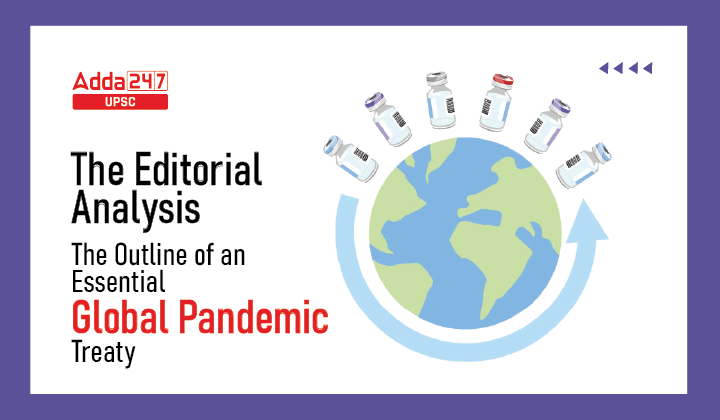Table of Contents
Global Pandemic Treaty- Relevance for UPSC Exam
- GS Paper 2: International Relations- Important International institutions, agencies and fora- their structure, mandate.
Global Pandemic Treaty in News
- World Health Organization (WHO) having declared the monkey-pox outbreak as a Public Health Emergency of International Concern (PHEIC) with over 32,000 cases from over 80 countries (August 2022).
- With this, the world faces the risk of another health crisis.
- A Global Pandemic Treaty was proposed at the Special Session of the World Health Assembly (WHASS).
- The underlying logic was that as global governance had failed during the pandemic, we needed political commitment to mitigate future challenges.
Impact pf COVID-19 Pandemic on Globe
- COVID-19 would count as being among some of the most severe pandemics the world has seen in the last 100 years.
- Death: An estimated 18 million people may have died from COVID-19, according various credible estimates, a scale of loss not seen since the Second World War.
- Economy: with over 120 million people pushed into extreme poverty, and a massive global recession, no single government or institution has been able to address this emergency single-handedly.
Widespread Global Health Inequity
- Widespread Inequality: Health-care systems have been stretched beyond their capacity and gross health inequity has been observed in the distribution of vaccines, diagnostics, and therapeutics across the world.
- While high-income economies are still recovering from the after-effects, the socioeconomic consequences of the novel coronavirus pandemic are irreversible in low and low middle-income countries.
- Profiteering despite Inequality: Companies such as Pfizer, BioNTech, and Moderna created billionaires since the beginning of the COVID-19 pandemic and made over $1,000 a second in profits, even as fewer of their vaccines reached people in low-income countries.
- As of March 2022, only 3% of people in low-income countries had been vaccinated with at least one dose, compared to 60.18% in high-income countries.
- The international target to vaccinate 70% of the world’s population against COVID-19 by mid-2022 was missed because poorer countries were at the “back of the queue” when vaccines were rolled out.
- Poor Funding: When world leaders pledged €7.4 billion ($8.07 billion) in a digital fundraiser for developing a coronavirus vaccine and treatments, the United States did not send any representative Thus, inequality has also been prolonging the course of the pandemic.
India’s Lead Role Countering COVID-19 Pandemic
- India’s response to the COVID-19 pandemic and reinstating global equity by leveraging its own potential has set an example to legislators worldwide.
- India produces nearly 60% of the world’s vaccines.
- India is said to account for 60%-80% of the United Nations’ annual vaccine procurement — “vaccine diplomacy” or “vaccine maitri” with a commitment against health inequity.
- India was unfettered in its resolve to continue the shipment of vaccines and other diagnostics even when it was experiencing a vaccine shortage for domestic use.
- There was only a brief period of weeks during the peak of the second wave in India when the vaccine mission was halted.
- As of 2021, India shipped 594.35 lakh doses of ‘Made-in-India’ COVID-19 vaccines to 72 countries — a classic example of global cooperation.
- Among these, 81.25 lakh doses were gifts, 339.67 lakh doses were commercially distributed and 173.43 lakh doses were delivered via the Covax programme under the aegis of Gavi, the Vaccine Alliance.
- India along with South Africa, moved a proposal to ask WTO ‘to allow all countries to choose to neither grant nor enforce patents and other intellectual property related to COVID-19 drugs, vaccines, diagnostics and other technologies for the duration of the pandemic, until global herd immunity is achieved’.
- Even though this proposal was stonewalled by some of the leading countries, it was only in June 2022, that the WTO finally decided to water down intellectual property restrictions in manufacturing COVID-19 vaccines after rigorous efforts.
Need for an Essential Global Pandemic Treaty
- Finalizing a Global Pandemic Treaty: a treaty under the umbrella of WHO would, as highlighted by the journal BMJ, build coherence and avoid fragmentation.
- such a treaty should cover crucial aspects such as data sharing and genome sequencing of emerging viruses.
- It should formally commit governments and parliaments to implement an early warning system and a properly funded rapid response mechanism.
- Further, it should mobilise nation states to agree on a set of common metrics that are related to health investments and a return on those investments.
- These investments should aim to reduce the public-private sector gap.
Conclusion
- A global pandemic treaty will not only reduce socioeconomic inequalities across nation states but also enhance a global pandemic preparedness for future health emergencies. India must take the lead in this.
The Editorial Analysis: In Pandemic Shock, Critical Lessons for MSMEs
The Editorial Analysis: In Pandemic Shock, Critical Lessons for MSMEs




 TSPSC Group 1 Question Paper 2024, Downl...
TSPSC Group 1 Question Paper 2024, Downl...
 TSPSC Group 1 Answer key 2024 Out, Downl...
TSPSC Group 1 Answer key 2024 Out, Downl...
 UPSC Prelims 2024 Question Paper, Downlo...
UPSC Prelims 2024 Question Paper, Downlo...





